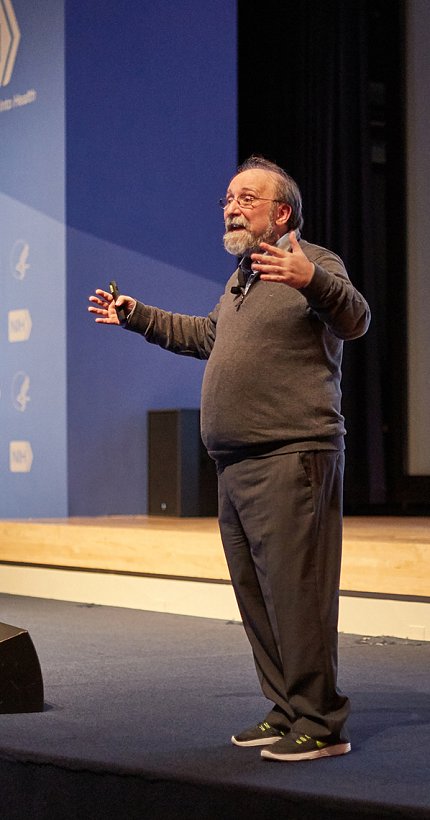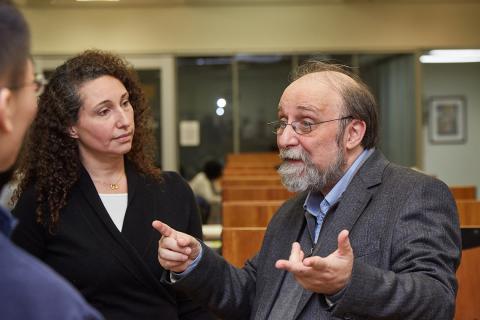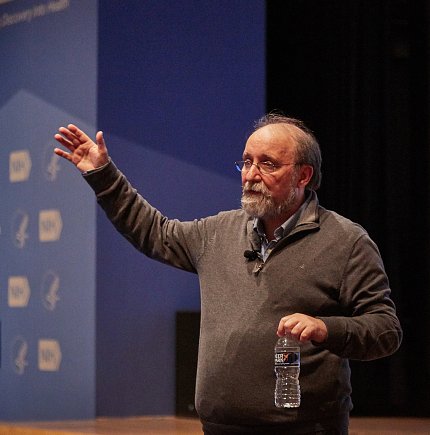Clinical Promise Shown
Nicolelis Outlines Progress in Brain-Machine Interfaces

Photo: Jeff Elkins
There is probably no other scientist in the world for whom peer review meant having his experiment succeed in front of a stadium full of 75,000 screaming Brazilians, with another 1.2 billion people watching on live television.
But at the start of the 2014 World Cup at Corinthians Arena in Sao Paulo, Dr. Miguel Nicolelis witnessed his patient Juliano Pinto, a paraplegic, not only kick a soccer ball to start the tournament, but also “feel” his foot striking the ball.
The patient, a former athlete outfitted with a brain-controlled robotic exoskeleton who had been paralyzed for 9 years, “didn’t say, ‘I kicked the ball!’” said Nicolelis. More importantly, he said, “I felt the ball!”
It took a team of 156 scientists from 25 countries on 5 continents to reach this moment for which neuroscientist Nicolelis had been preparing for 20 years. He recruited the team by dangling field tickets to the World Cup in front of potential recruits.
“It was a hard way to win a free ticket to the game, but that is the Brazilian way,” quipped Nicolelis, a native of that country.
Now a professor of neuroscience at Duke University School of Medicine, Nicolelis, who won an NIH Pioneer Award in 2010 for work he said couldn’t earn a penny of funding a decade earlier, spoke Oct. 16 at an NIH Director’s Lecture in Masur Auditorium.
In the late 1980s, Nicolelis, who has been NIH-funded for 31 years, first recorded extracellular signaling from the brain of a rhesus monkey. Since then, he and colleagues have established a set of 10 principles governing neurocircuit plasticity and dynamics that appear to hold true across mammalian species.
Their most important basic science findings, he said, include “principles of neural ensemble physiology,” which involve “distributed coding, plasticity and multitasking—a single neuron is informative of several behavioral parameters.”
Nicolelis and his team at Duke set out to record brain-firing in animals “completely free to behave” any way they want, which is a courtesy, minus electrode-implantation, he proudly extends to his graduate students.
They began with rats, using chronic implants capable of recording hundreds of cells at once, for long periods of time. Nowadays, they use 3-D-printed recording cubes that can be implanted 10 at a time, 5 in each monkey brain hemisphere.
“These are flexible filaments, not rigid electrodes,” Nicolelis explained. “They move and flow with the tissues. They work months and years after implantation.” The researchers can link a single neuron per wire and are now up to 800-900 wires per animal.

Photo: Jeff Elkins
“Monkeys can live for a decade after the implant,” Nicolelis said. His current record is 7.5 years in 2 monkeys.
Microchips within the cubes send information wirelessly to nearby computers that record which neurons in the brain encode specific movements. It turns out that the primary motor cortex is the seat of movement in mammals.
By mapping the neurocircuitry from thought to action, Nicolelis’s team could train monkeys to graduate from using a low-friction joystick to complete a visual task resulting in the reward of orange juice or grapes (“As you know, monkeys will do anything for orange juice,” Nicolelis explained, “and they like grapes even more than they like juice.”) to using their eyes alone to guide cursor movement toward the reward.
“To our shock, we learned that monkeys could move the cursors with their eyes, not the stick,” said Nicolelis.
In only a week of conditioning trials, monkeys could learn to guide an electronic wheelchair toward a plate of grapes—using the brain alone—as easily as they could by hand. This proved the concept of brain-machine interfaces (BMI): Animals can neurally control tools as if they are natural extensions of their own body.
It was a short leap from there to the design of novel neuroprosthetic devices such as the one that helped Pinto kick his soccer ball.
That very public success had been preceded by a search, among the 65,000 patients suffering paralysis in Brazil, to a group of 8 finalists. Unlike animal experiments, in which electrodes are implanted, noninvasive EEG is the mode of BMI in humans.
Patients with paralysis typically have no sensation below the level of the spinal lesion. But some tactile sensation can remain in the forearm; this is where Pinto “felt” the sensation of kicking the ball, via a haptic display on his arm.
“Some of our patients develop a vivid phantom sensation of their legs,” said Nicolelis. “They have literally used their brains to adjust the parameters of their feedback.”
In 3 months of training, sometimes in front of mirrors to gain additional feedback, all 8 finalists for the World Cup event—who had been complete paraplegics—became proficient at using a robotic exoskeleton to take steps, said Nicolelis.
Pinto himself eventually regained feeling in his toes and became a partial paraplegic, following sufficient training.
Nicolelis has known patients to regain bladder and sphincter control, below the level of the lesion that caused paralysis, and one patient even conceived and bore a healthy baby.
“The return of autonomy—that is our goal,” he said.

Photo: Jeff Elkins
Nicolelis is betting that BMI, paired with virtual reality, can rekindle the cortex, enabling patients to perform complex locomotion. “In stroke victims, we believe BMI can induce some level of recovery.”
He showed videos of Parkinson’s disease patients whose gait could be dramatically improved via electrical stimulation of the spinal cord. “We have 100 patients around the world in a trial, and it’s working in all of them,” he reported.
And therapy needn’t be continuous. One dose can last for days.
Nicolelis is now targeting epilepsy: “We hope to be able to modulate seizures, via the spinal cord, within the next 20 or 30 years—however much time I have left.”
During a brief post-lecture Q&A, a query by a man describing himself as a presidential candidate from the U.S. Transhumanist Party—who cited Elon Musk as an authority—gave Nicolelis an opportunity to state unequivocally that “human problems are going to be solved by humans, not by technology.”
The complete talk is available at https://videocast.nih.gov/summary.asp?Live=35101&bhcp=1.
